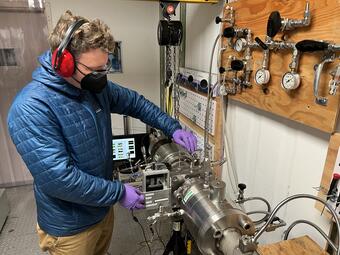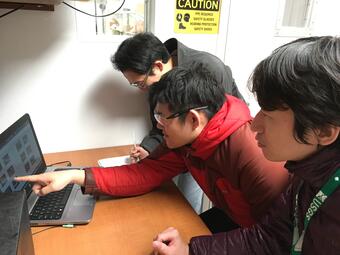Gas Hydrates Project Hydrate Pressure Core Analysis Laboratory (HyPrCAL)
The USGS Gas Hydrates Project manages the standalone Hydrate Pressure Core Analysis Laboratory (HyPrCAL) at the Woods Hole Coastal and Marine Science Center (WHCMSC) to study hydrate-bearing sediments in support of energy resources and geohazards research.
Gas Hydrates Project

The USGS Gas Hydrates Project has been making contributions to advance understanding of US and international gas hydrates science for at least three decades. The research group working on gas hydrates at the USGS is among the largest in the US and has expertise in all the major geoscience disciplines, as well as in the physics and chemistry of gas hydrates.
Pressure coring is the state-of-the-art method for obtaining samples from hydrate-bearing sediment formations and has been widely used in deepwater marine environments for more than two decades even as the technology has dramatically evolved. Pressure coring is also a key component of the Alaska North Slope hydrate well project. The USGS Gas Hydrates Project has analyzed pressure cores from the Nankai Trough MH21 program, the National Gas Hydrates Program 02 (NGHP-02) offshore India, and the DOE-sponsored northern Gulf of Mexico program managed by the University of Texas-Austin.
The HyPrCAL facility, which was funded by the U.S. Department of Energy’s National Methane Hydrates R&D Program, hosts the Pressure Core Characterization Tools (PCCTs). These tools were originated by USGS collaborator J. Carlos Santamarina at Georgia Tech and transferred to the USGS in 2015. The PCCTs consist of a manipulator to move pressure core sediments between storage chambers and specialized cells; a customized saw to cut off lengths of sediment core while maintaining them at high pressures; and a suite of pressure cells that can be used to measure the strength, compressibility, permeability, and other characteristics of hydrate-bearing sediments. Constraining the properties of pressure cores provides information about whether sediments will collapse during drilling, how much methane can be extracted from the gas hydrate, and which processes are necessary to sustain gas hydrate dissociation in a production well.
In recent years, USGS researchers have designed and built additional tools and pressure cells to manipulate and interrogate pressure cores. For example, researchers have redesigned parts of the PCCTs to accommodate wider-diameter pressure cores. A new cell with a sapphire window allows researchers to see the sediment sample as it moves through the manipulator. A high-stress triaxial permeameter cell constructed in 2021 will permit measurement of both permeability and relative permeability of hydrate-bearing sediments once fully tested.
In addition to analyzing pressure cores, the USGS Gas Hydrates Project also contributes expertise in transport and storage of these special samples. Using a design originated by Georgia Tech, USGS researchers have overseen the construction and certification of special storage chambers that can be used to maintain, monitor, and transport pressure core samples from the field site to specialized laboratories.









